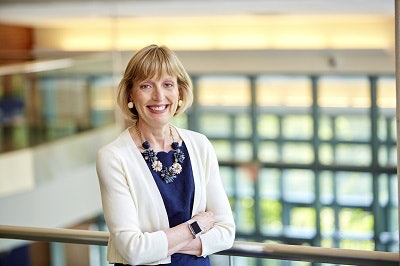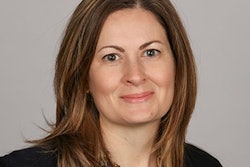After varying amounts of struggle, higher ed institutions across the country moved online for the spring semester in response to the coronavirus pandemic. But now the question is, what’s next?
While some hope campuses will re-open come fall, no one knows for certain. In the meantime, higher ed leaders are girding themselves for the possibility they’ll have to offer another semester online and asking themselves how to best prepare for more long-term remote learning.
 Dr. Alison Davis-Blake
Dr. Alison Davis-BlakeAbout 58% of institutions are considering or have already decided to continue online in the fall, while 73% are considering or have already expanded their online course offerings for next semester, according to a survey from the American Association of Collegiate Registrars and Admissions Officers.
Many higher education professionals are thinking outside the box — and outside the (virtual) classroom — about what resources students will need if online classes continue next year.
Over spring break, most campuses didn’t have the time to build the highest quality online programs as they scurried to open their virtual doors, but fall may hold new possibilities.
Clare McCann, deputy director for federal higher education policy at the think tank New America, stressed the importance of “instructional design” as well as online student supports like academic and personal counseling now that schools have a “small (albeit very small) extra amount of time to prepare.”
To prevent students from disengaging, universities also need to facilitate more interpersonal interaction between faculty, students and their peers, she added, “as often as possible and in different formats.”
In particular, online education is hardest for people who are academically underprepared, the kinds of students who might take advantage of tutoring or office hours if they were on campus. So, McCann stressed the importance of finding remote ways to fill those gaps and check up on students to ensure they’re keeping up with the material.
The goal should be “making sure there’s some sense of classroom, some sense of community and shared learning experience,” she said. “That’s been most effective in helping students succeed in this online format.”
In that vein, Dr. Alison Davis-Blake, president of Bentley University, is working to create a “true virtual campus,” not just online courses, she said, to offer as much of the campus experience as possible online.
For example, the school held an online career fair and continues to offer remote career counseling. Groups of 40 students virtually meet with a student affairs representative for weekly check-ins and coaches continue to touch base with their athletes, even though they can’t play. Student government is up and running, alongside fraternities, sororities and other student groups that continue to virtually meet.
The university plans to look at student and faculty surveys this summer to assess its online education this spring, and most importantly, what could be improved in the fall if remote classes continue. The hope is to offer more “experiential learning” opportunities and to make more on-campus services remotely available.
The onboarding challenge
But as Davis-Blake pointed out, an online fall semester would pose a new challenge: onboarding a first-year class amidst the pandemic.
Higher ed leaders are asking themselves, “How do you orient students when you’re not face to face?” she said. “What can you do over the summer to bring students in?”
She’s thinking through a number of options — virtual tours, group chats for new students, or even small regional group gatherings, if they’re safe when the semester starts.
Preparing for the possibility of a fall semester online, “it’s almost as if you’re building a university from the ground up,” Davis-Blake said. For colleges, the key is “thinking about what is an important part of your campus experience? And [then] trying to bring that forward.”
McCann worries that this building process may prove daunting to colleges and universities, causing them to rely on online program management companies that may not serve them well.
While these companies will take care of schools’ online programming for them — a tempting possibility for schools wrestling with online learning — the risk is “outsourcing to companies that don’t affiliate with the institution, that don’t have the same mission or quality standard,” she said. “It’s a bigger issue that we’ve been seeing for the last several years.”
Part of the problem is that the business model for online program management companies is often that they get a cut of tuition, so it’s in their interest to aggressively recruit students, especially underrepresented students, regardless of whether they’ll have the resources to succeed.
“It makes it all the more important that institutions be thinking about how to serve these students as well as they need to be serving them,” she said. “Bringing them in just to see them flounder and fail while you’re still engaged in this online learning would not be good.”
Staying connected
Dr. Wayne A. I. Frederick, president of Howard University, is contending with the question of how to best serve his students in an online environment. The historically Black college (HBCU) is known for its family dynamic, he said, so he’s considering what that means and what that looks like if students remain online in the fall.
The camaraderie students feel at an HBCU is “difficult to create in a distance learning environment,” he said. “We do have to start thinking, ‘What are our values, what are our traditions, and how do we uphold those in the middle of a crisis such as this?’”
For all universities, but particularly schools like Howard, which serve high percentages of low-income students, the possible continuation of online learning comes with another worry — retention rates.
 Dr. Wayne A. I. Frederick
Dr. Wayne A. I. FrederickFrederick is concerned that students financially impacted by the coronavirus may not come back to campus next year, so continuing online options in the fall — even if on-campus classes are safe — might help students who need to work and might otherwise struggle to return, he said. In the meantime, part of the school’s preparation for fall is carefully monitoring students and reaching out to those who may need help with their finances.
Frederick finds that the crisis, and the accompanying shift online, is impacting his students in diverse ways, with Black communities disproportionately affected by the coronavirus. Some need mentorship; others need devices just to get online; and, as a student survey found, many need quiet spaces to study at home.
So, as time goes on, he wants to continue “tailoring” services to their individual needs. For example, if places like libraries reopen before campuses, Howard University might create a guide to finding safe, local study spots.
In preparing for the fall, “we need to ask our students what they need rather than be prescriptive,” he said.
Though everyone hopes for more normalcy in the next academic year, Davis-Blake thinks the process of making emergency plans for fall might actually help universities understand and address their students’ needs better. Campuses may find that some supports actually reach more students more effectively online, while others require an in-person touch.
“I really believe this is a period not just to hunker down and say, ‘Well, how do we get through?’” she said. “This is a time for creativity. Even if we come back to campus and we’re all face to face, there are things we’re learning and will keep learning about how to deliver education even better through virtual and in-person activities. In every calamity, there is a possibility and an opportunity for innovation, for growth, for the human spirit to really rise.”
This article originally appeared in the April 30, 2020 edition of Diverse. You can find it here.





















